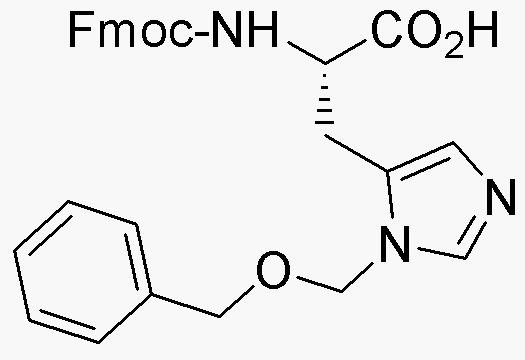Fmoc-His(3-Bom)-OH is widely utilized in research focused on:
- Peptide Synthesis: This compound serves as a key building block in the synthesis of peptides, particularly those containing histidine. Its protective Fmoc group allows for selective deprotection during the synthesis process, enhancing efficiency and yield.
- Drug Development: In pharmaceutical research, it is used to create histidine-containing peptides that can act as potential drug candidates, especially in targeting specific biological pathways or diseases.
- Bioconjugation: The compound facilitates the attachment of biomolecules, such as proteins or antibodies, to therapeutic agents, improving their efficacy and targeting capabilities in treatments like cancer therapy.
- Research in Biochemistry: It is employed in studies investigating enzyme activity and protein interactions, providing insights into metabolic pathways and cellular functions.
- Diagnostics: The compound can be utilized in the development of diagnostic tools, particularly in assays that require histidine for binding or detection purposes, enhancing the sensitivity and specificity of tests.
General Information
Properties
Safety and Regulations
Applications
Fmoc-His(3-Bom)-OH is widely utilized in research focused on:
- Peptide Synthesis: This compound serves as a key building block in the synthesis of peptides, particularly those containing histidine. Its protective Fmoc group allows for selective deprotection during the synthesis process, enhancing efficiency and yield.
- Drug Development: In pharmaceutical research, it is used to create histidine-containing peptides that can act as potential drug candidates, especially in targeting specific biological pathways or diseases.
- Bioconjugation: The compound facilitates the attachment of biomolecules, such as proteins or antibodies, to therapeutic agents, improving their efficacy and targeting capabilities in treatments like cancer therapy.
- Research in Biochemistry: It is employed in studies investigating enzyme activity and protein interactions, providing insights into metabolic pathways and cellular functions.
- Diagnostics: The compound can be utilized in the development of diagnostic tools, particularly in assays that require histidine for binding or detection purposes, enhancing the sensitivity and specificity of tests.
Documents
Safety Data Sheets (SDS)
The SDS provides comprehensive safety information on handling, storage, and disposal of the product.
Product Specification (PS)
The PS provides a comprehensive breakdown of the product’s properties, including chemical composition, physical state, purity, and storage requirements. It also details acceptable quality ranges and the product's intended applications.
Certificates of Analysis (COA)
Search for Certificates of Analysis (COA) by entering the products Lot Number. Lot and Batch Numbers can be found on a product’s label following the words ‘Lot’ or ‘Batch’.
*Catalog Number
*Lot Number
Certificates Of Origin (COO)
This COO confirms the country where the product was manufactured, and also details the materials and components used in it and whether it is derived from natural, synthetic, or other specific sources. This certificate may be required for customs, trade, and regulatory compliance.
*Catalog Number
*Lot Number
Safety Data Sheets (SDS)
The SDS provides comprehensive safety information on handling, storage, and disposal of the product.
DownloadProduct Specification (PS)
The PS provides a comprehensive breakdown of the product’s properties, including chemical composition, physical state, purity, and storage requirements. It also details acceptable quality ranges and the product's intended applications.
DownloadCertificates of Analysis (COA)
Search for Certificates of Analysis (COA) by entering the products Lot Number. Lot and Batch Numbers can be found on a product’s label following the words ‘Lot’ or ‘Batch’.
*Catalog Number
*Lot Number
Certificates Of Origin (COO)
This COO confirms the country where the product was manufactured, and also details the materials and components used in it and whether it is derived from natural, synthetic, or other specific sources. This certificate may be required for customs, trade, and regulatory compliance.


